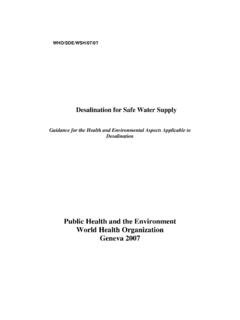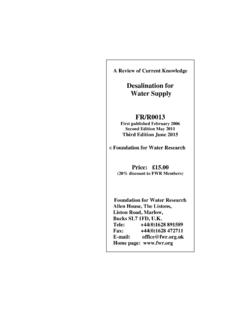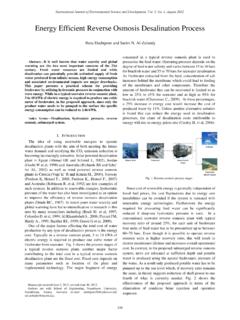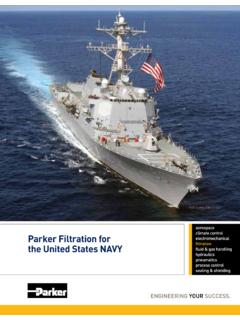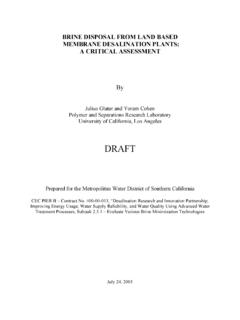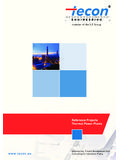Transcription of Water, Sanitation and Hygiene Household Survey Gaza
1 water , Sanitation and Hygiene Household Survey Gaza Funded by Photo credit: UNICEF-oPt/2009/ElBaba Palestinian Hydrology Group For water and Environmental Resources Development WASH Household Survey , Gaza UNICEF and PHG 2010 April, 2010 Acknowledgements: We would like to express our gratitude to the team, all the families that cooperated with us, and the WASH Cluster. Maps herein have been prepared solely for the convenience of the reader; the designations and presentation of material do not imply any expression of opinion of the United Nations or UNICEF, or the Department for International Development (DFID) as to the legal status of any country, territory, city , or area, or of the authorities thereof, or as to the delimitation of boundaries or national affiliation.
2 6 Table of Contents LIST OF ABBREVIATIONS .. 7 LIST OF FIGURES .. 7 EXECUTIVE SUMMARY .. 8 1. INTRODUCTION .. 10 Background .. 10 Methodology .. 10 2. ANALYSIS OF RESULTS .. 14 Drinking water .. 14 Domestic water .. 17 Wastewater .. 20 Solid wastes .. 22 Hygiene .. 24 Health .. 26 RECOMMENDATIONS .. 28 1) Advocate for an end to the Gaza blockade .. 28 2) Conduct a comprehensive Household needs assessment .. 28 3) Introduce additional desalination units .. 28 4) Strengthen monitoring and surveillance systems .. 28 5) Promote environmental awareness and Hygiene .. 28 REFERENCES .. 29 ANNEX A QUESTIONNAIRE.
3 30 ANNEX B COLOUR CODING SYSTEM .. 33 ANNEX C STATISTICAL RESULTS .. 36 ANNEX D COLOUR CODED RESULTS .. 53 7 List of Abbreviations AIDA Association of International Development Agencies CMWU Coastal Municipalities water Utility EWASH Emergency water , Sanitation and Hygiene Group GVC Gruppo Di Volontariato Civile NIS New Israeli Shekels PCBS Palestinian Central Bureau of Statistics PHG Palestinian Hydrology Group PWA Palestinian water Authority RO Reverse Osmosis SPSS Statistical Package for Social Sciences UN HCT United Nations Humanitarian Country Team UNEP United Nations Environment Programme UNICEF United Nations Children s Fund UNRWA United Nations Relief and Works Agency WASH water .
4 Sanitation and Hygiene WASH MP water , Sanitation and Hygiene Monitoring Programme WHO World Health Organization List of Figures FIGURE 1: SAMPLE DESIGN FOR Survey 12 FIGURE 2: SAMPLE DESIGN STEPS 12 FIGURE 3: EVALUATION TOOL TEMPLATE 13 FIGURE 4A: PRIMARY SOURCE OF DRINKING water 14 FIGURE 5: DRINKING water STATUS IN GAZA 16 FIGURE 6: FREQUENCY OF RUNNING water supply 17 FIGURE 7: PRIMARY SOURCE OF DOMESTIC water 17 FIGURE 8: PRIMARY SOURCE OF COOKING water 18 FIGURE 9: SUFFICIENCY OF water supply 18 FIGURE 10:DOMESTIC water STATUS IN GAZA 19 FIGURE 11: CONNECTIVITY TO WASTEWATER NETWORK 20 FIGURE 12: STAGNANT SEWAGE 20 FIGURE 13: WASTEWATER STATUS IN GAZA 21 FIGURE 14: FREQUENCY OF SOLID WASTE COLLECTION 22 FIGURE 15: ACCUMULATION OF SOLID WASTE 22 FIGURE 16: SOLID WASTE STATUS IN GAZA 23 FIGURE 17: APPROPRIATE MATERIAL FOR MENSTRUATION 24 FIGURE 18: Hygiene STATUS IN GAZA 25 FIGURE 19: DIARRHEAL INFECTIONS IN CHILDREN LESS THAN 5 YEARS OLD 26 FIGURE 20.
5 DIARRHEAL INFECTIONS IN CHILDREN 27 8 Executive Summary Gaza s million residents rely on the Coastal Aquifer to supply them with water but overuse and contaminants seeping into the ground are threatening this vital resource. UN agencies and the Coastal Municipal water Utility (CMWU) estimate the aquifer s supply of water , suitable for human consumption, will disappear over the next five to 10 years. Exacerbating the problem is the decrepit state of Gaza s Sanitation services. Israel s blockade of Gaza since 2007 and its 23 day military operation in this tiny Palestinian territory during the 2008-09 winter has pushed Gaza s water and wastewater system to the edge of collapse.
6 Israel s operation Cast Lead destroyed large tracts of public infrastructure including the water and sewerage system. More than 30 kilometres of water networks, 11 groundwater wells, 6,000 roof tanks and 840 Household connections were damaged, leaving around 500,000 people without clean water . Deficient supplies of industrial fuel and the severe, almost non-existent, supplies of essential materials such as cement and pipes for repair and maintenance work have rendered the water and wastewater services unreliable and hazardous. Ninety eight per cent of Gazans are connected to the water network but access to a continuous supply of running water is much less widespread.
7 supply is intermittent, with just 48 per cent of surveyed households reporting running water four to seven days a week and 39 per cent just two to three days a week. Despite the limited supply , 54 per cent say they are satisfied with the quantity of water , perhaps because most households store water in ground and roof top water tanks for use when there is no running water . Most households do not use municipal water supplies for drinking, as 90 to 95 per cent of the aquifer, Gaza s only water source, is considered unfit for human consumption due to levels of chlorides and nitrates as high as six times the WHO guidelines.
8 While there is no in-depth research or evidence yet on impact to public health, elevated levels of nitrates can lead to methemoglobinaemia, or blue baby syndrome among Risks of other water -borne disease including typhoid or 1 Infants suffering from methemoglobinaemia may appear otherwise healthy but exhibit intermittent signs of blueness around the mouth, hands and feet. They may have episodes of breathing trouble, diarrhoea and vomiting. In some cases, infants with methemoglobinaemia have a peculiar lavender colour but show little distress.
9 Blood samples appear chocolate brown and do not turn pink when exposed to air. When the methemoglobin level is high, infants express a marked lethargy, excessive salivation and loss of consciousness. Convulsions and death can occur when methemoglobin levels are extremely high. 9 hepatitis are also present because the water table is not deep and sewage infiltration is probable. While households in Beit Lahiya and Tal el Hawa use water filters to purify water , per cent of the households surveyed buy their drinking water from unregulated private vendors selling desalinated water for an average cost of NIS 35/ m3 rates unaffordable for poor households.
10 Eighty-six per cent of respondents rely on the network for water for domestic purposes such as cooking and washing. Although more than 47 per cent of the respondents say they are reluctant to use water from the network for cooking, many are forced to do so due to the high cost of privately-supplied water . Cooking heightens the concentration of nitrates and other salts even further. More than 79 per cent of the surveyed households are connected to a wastewater network and the remainder have cesspits. Although sewage stagnation was expected due to the hydro-geologic condition of Gaza, no serious stagnation was reported primarily because the Survey was conducted outside of the rainy season.










